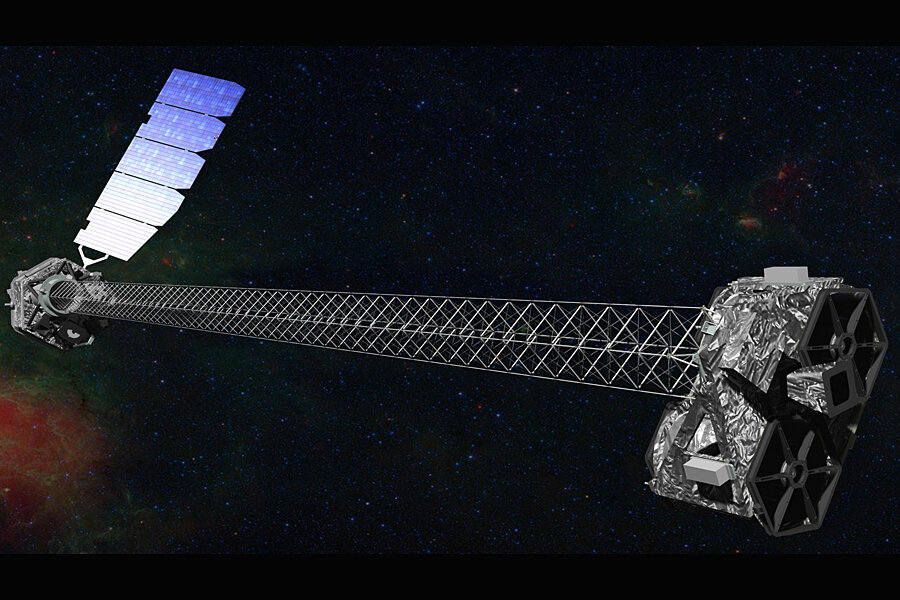What made a star explode? NASA now can sift through its entrails.
Loading...
Sifting through the cosmic ashes of Cassiopeia A, an exploded star some 11,000 light-years away, astronomers have for the first time uncovered direct evidence of the conditions that existed at the star's core mere minutes before it blew up.
The evidence appears as a radioactive form of titanium. Along with nickel, titanium represents the last element the star formed at its core before its fusion furnace was quenched and the star collapsed, followed by the blast.
As a result, this radioactive titanium "tells us what was going on in the guts of the explosion," said Brian Grefenstette, a planetary scientist at the California Institute of Technology in Pasadena, Calif., during a briefing Wednesday on the discovery.
The observation is helping researchers sift through competing explanations for what happens during what's known as core-collapse supernovae. Since the earliest era of star formation some 13.5 billion years ago, these events have enriched the cosmos with a wide variety of elements heavier than the primordial hydrogen and helium that served as the raw material for the first stars.
This enrichment process produced elements such as carbon, nitrogen, oxygen, and phosphorous – essential to organic life. The process also contributes metals, including gold, that some of these life forms use for tools or jewelry.
Until now, researchers have had to rely on computer simulations to explain what happens moments before such explosions occur.
NASA's orbiting X-ray observatory NuSTAR, launched in 2012, has changed that, however. It has mapped the distribution of titanium-44, a radioactive form of the metal, in the shell of material expanding outward from Cassiopeia-A’s center. Titanium-44 forms in the same location as nickel-56, which delivered the coup de gras to the star's fusion reactions.
The data show that the expanding shell of titanium atoms is clumpy and that the general shape of the shell is distorted, rather than spherical, notes Dr. Greffenstette. He is the lead author of a research paper reporting the results – which involved researchers from seven countries – in Thursday's issue of the journal Nature.
These features support one of two broad explanations for the mechanism driving the explosions from core-collapse supernovae, what one might call the pressure-cooker model.
Under this scenario, as a star at least eight times as massive as the sun collapses, pressure rises at the core, heating it and releasing enormous concentrations of tiny particles called neutrinos. Ordinarily, these particles rarely interact with matter and so flit through space unimpeded, except when they encounter matter as dense as the matter in the collapsing core.
These particles heat the gas behind the shock wave, Greffenstette explains, causing bubbles to rise into the cooler gas above. This motion causes the shock wave to slosh.
Once the bubbles burst through the shock wave, "it's like blowing the top off of a pressure cooker and the shock wave rips apart the star," he said.
The second broad explanation holds that as the star collapses, it spins up and forms jets of material that erupt from its poles. These jets then blast the star apart. But the distribution of titanium within Cassiopeia-A’s expanding nebula shows no evidence of such jets.
The nebula has been observed at a wide range of wavelengths for years, including X-ray wavelengths by NASA's Chandra X-Ray Observatory, currently on orbit, as well as NASA's Spitzer Space Telescope, which sees at infrared wavelengths. But Chandra wasn't designed to detect the higher-energy X-rays that come from radioactive decay; it picks up lower-energy X-rays that come from heating an element, researchers say, something shock waves do as they pass through the ejected material.
Observations from Chandra and Spitzer, on the one hand, and NuSTAR, on the other, present a conundrum. NuSTAR sees the titanium as an innermost shell in Cassiopeia’s expanding nebula. In principle, iron should be there, too, since titanium's companion at the doomed core, nickel, decays within several days of the explosion into a radioactive form of cobalt, which then decays into iron.
But Chandra sees iron out toward the nebula's edge, where it's heated by a shock wave rebounding in toward the center. NASA's Spitzer Space Telescope, which observes in the infrared and so at cooler temperatures, sees no evidence for iron in the nebula's still-cool region where the titanium appears.
The case of the misplaced iron could be explained if the supernova's progenitor collapsed into a bizarre form of star known as a quark star first, suggests J. Martin Laming, an astrophysicist at the US Naval Research Laboratory in Washington.
The transition to a quark star would entail a second explosion, which would have boosted the concentration of titanium and dispersed the iron. But this mechanism remains controversial, he writes in an article that accompanies the formal report of the Cassiopeia-A observations in Nature.








